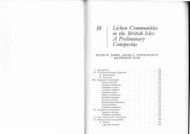You also want an ePaper? Increase the reach of your titles
YUMPU automatically turns print PDFs into web optimized ePapers that Google loves.
hypochlorite produce corrosion and bleaching. It<br />
is self evident that contact with the eyes is<br />
hazardous. If this comes to pass, immediately<br />
rinse the region <strong>of</strong> the eye with flowing water.<br />
Reagents for the Determination <strong>of</strong> <strong>Lichens</strong><br />
The following reagents are required: 1.<br />
Potassium hydroxide (Abbreviation: K), 2.<br />
Calcium or sodium hypochlorite (C), 3.<br />
Para-Phenylediamine (P), and 4. Iodine solution<br />
(J). The regents keep longer when stored in<br />
brown bottles and in the dark.<br />
Potassium hydroxide: 2-4 g <strong>of</strong> potassium<br />
hydroxide is dissolved in 20 cc <strong>of</strong> water. The<br />
solution is infinitely stable. A false judgment <strong>of</strong><br />
the yellow reaction is sometimes possible, since<br />
K makes the cortex transparent and the<br />
underlying yellow-green algae layer gives a<br />
misleading ± yellow-greenish coloring (see<br />
remedy below: white filter paper).<br />
Calcium Hypochlorite or Sodium<br />
Hypochlorite Solution: Calcium hypochlorite is<br />
obtained by dissolving chloride <strong>of</strong> lime<br />
(bleaching powder) in water to saturation. Since<br />
at best the solution is stable for one day and in<br />
addition the precipitating chloride <strong>of</strong> lime may<br />
cause annoying whitish flecks, it is better to use<br />
sodium hypochlorite solution. They must<br />
however be renewed from time to time, at best<br />
every two months. Equally effective are chlorine<br />
containing household cleansers (e.g. Clorox, also<br />
only <strong>of</strong> finite stability). Verification <strong>of</strong> the<br />
strength <strong>of</strong> the solution is produced by a simple<br />
test with a test lichen (e.g. Hypocenomyce<br />
scalaris). The reaction with C is <strong>of</strong>ten very<br />
fleeting, therefore observe immediately!<br />
In the case <strong>of</strong> the occasionally needed KC<br />
reaction, first potassium hydroxide is used, then<br />
C is brought to the same test site. As a rule, in<br />
this way the C reaction is stronger and more<br />
definite; the KC reaction is not however always<br />
identical to the C reaction. In rare instances a<br />
CK reaction is asked for (first C, then K!).<br />
In the case <strong>of</strong> the test with KC on yellowish<br />
species proceed in the following manner: lay a<br />
piece <strong>of</strong> lichen on a slide and drop a little K over<br />
it. After a little time take up the K with white<br />
filter paper. Afterwards put a drop <strong>of</strong> C on the<br />
paper and observe the color.<br />
Para-Phenylendiamine solution: This reagent<br />
is poisonous and leaves behind flecks on clothing<br />
etc. (see above). Do the reaction with P when it<br />
is stated in the species description. Avoid<br />
however the reaction with P on principle, when it<br />
is not essential for the determination.<br />
The reagent (according to Steiner) is prepared<br />
as follows: 1 g para-Phenylenediamine, 10 g<br />
sodium sulfite and 1ml <strong>of</strong> a detergent in 100 ml<br />
water. In this form it is stable for more than a<br />
month.<br />
An alternative to the health threatening para-<br />
Phenylenediamine is <strong>of</strong>fered by the Color<br />
Developer 1 <strong>of</strong> Merck; it was formulated for the<br />
color film developer process. According to the<br />
formula: 10 g sodium sulfite, as (Na2SO3)<br />
completely dissolved in distilled water + 3 g<br />
N 4 ,N 4 -Diethyl-1,4-phenylene-diaminesulfate<br />
(color developer) + 1 ml <strong>of</strong> a detergent, shake<br />
until completely in solution. The solution is<br />
stable for more than a month. The reactions with<br />
this reagent appear merely somewhat later on and<br />
the color is in the majority <strong>of</strong> cases pale (orange<br />
instead <strong>of</strong> red).<br />
Iodine Solution, for the study <strong>of</strong> the reactions <strong>of</strong><br />
the hymenium and <strong>of</strong> asci best in the form <strong>of</strong><br />
Lugol’s Solution (Merck): 0.5 g iodine, 1.5 g<br />
potassium iodide, 100 ml distilled water. A<br />
pretreatment with 10% potassium hydroxide is<br />
advantageous, in making possible reliable<br />
statements in studies <strong>of</strong> ascus structure. The<br />
abbreviation for this is K/I.<br />
Over sight <strong>of</strong> the most important lichen substances and their reactions<br />
Explanation: Indicated color reaction only with a sufficient concentration <strong>of</strong> the lichen substance. Above all<br />
in the case <strong>of</strong> P the reaction <strong>of</strong>ten alternates between yellow-orange and red. In parenthesis: in practice the<br />
reaction (on the lichen) is <strong>of</strong>ten unclear or fails to appear, therefore to be carried out on isolated material.<br />
Without indication: reaction the lichen negative, not proven on isolated material.<br />
Reagent K C KC P<br />
α-collatolic acid - - (red) -<br />
Alectorialic acid yellow red red yellow<br />
Alectoronic acid - - (red) -<br />
Angardianic acid - - - -<br />
Aotearon - - - -<br />
14





